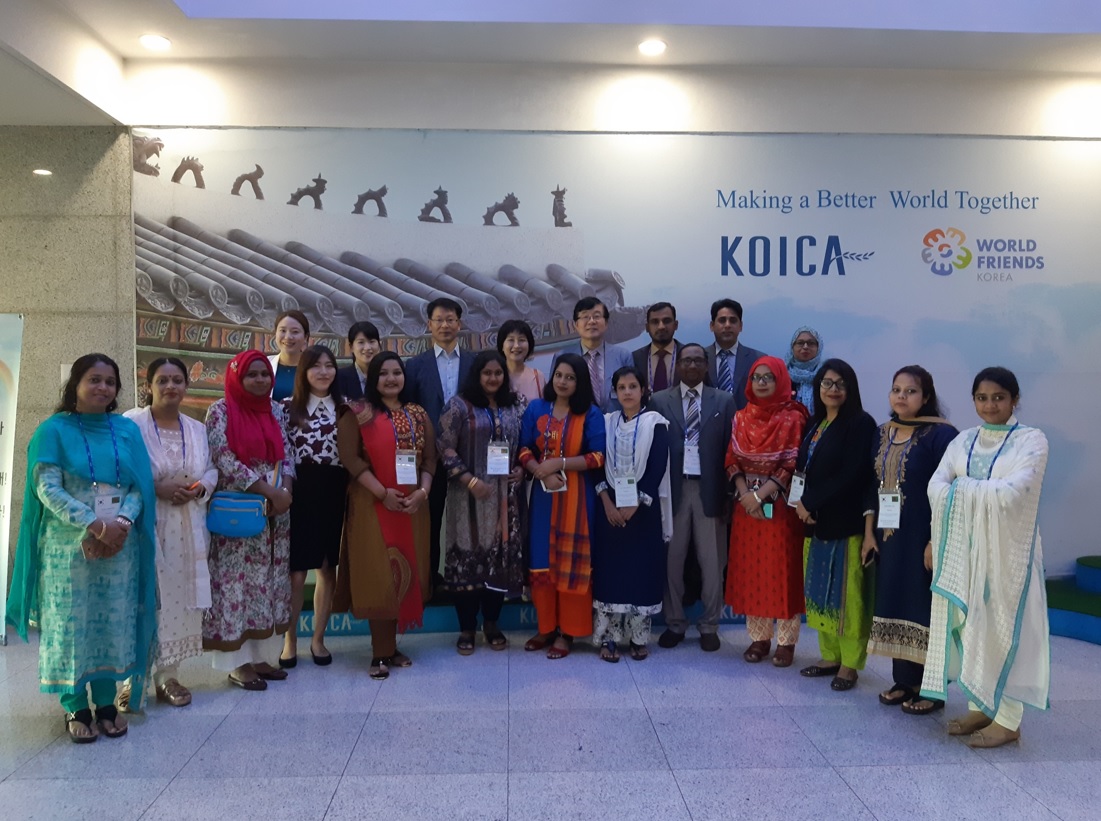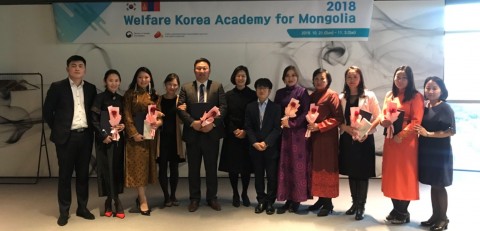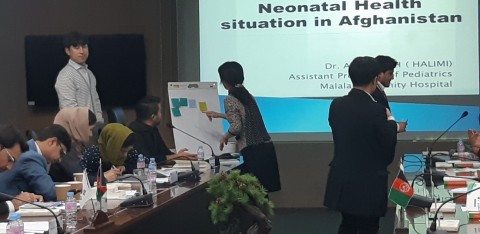Realizing SDGs Goal 10th through Health & Welfare Education for Developing Countries
Description
Below stories shows how we make stepping stones for sustainable development by our education projects. Our objective and key stakeholders will be introduced first. They are people of all social strata, and each group has different experiences and specialties. Next, this case shows the results and impacts of the projects such as newly developed law and policies, or willingness to make them. The latest education projects for developing countries can be good examples. Then, we tell about the factors behind our success. Lastly, we suggest the possibility we have that includes the sustainability and room for development in our projects.
Depending on the purpose of our institution, we would like to contribute to the development of the health and welfare sector for creating a better society. These include welfare schemes that cover the underprivileged and equitable healthcare environment for everyone. To this end, we take advantage of our expertise of education. Our well-built training programs can also be used for sustainable development in developing countries. These trainings inspire public workers such as policy makers in developing countries to make their own development.
1. Beneficiaries: Public officers from developing countires
2. Korean Government
3. Non-Governmental Organization: NGOs with Korea NGO Council
4. Health and Medical Industry: Public or private hospital
5. Welfare Industry: Central or Local community welfare business
6. Academia: Universities or Research Institutes
7. Youth: Korean Association for Students
We and our partners from various social sectors have spared many years for the sustainable development. In particular, we, Korea HRD Institute for Health and Welfare use our specialized area; plan and operating capacity building programs, to eliminate inequalities within and among countries. Here are descriptions of our efforts, and we would like to introduce them by the following two categories.
1. Lao PDR case
- In the past, Lao PDR had low-level social welfare services. There was a lack of welfare-related systems and laws, welfare facilities for the vulnerable, and basic-level social security information system.
- We offer the training program for improvement of welfare system of Lao PDR. It consists of lectures, field trips, and workshops for improving their welfare policies and systems, such as social assistance, social insurance, and pension.
- Policy Makers from the Ministry of Labor and Social Welfare of Lao PDR are conducting innovation activities for their welfare system after the training program. They work for underprivileged in Lao PDR based on the knowledge and inspiration from the training program. We believe that they can get rid of the inequalities in trainee’s country for their sustainable development.
2. Bangladesh case
- Bangladesh tried to improve the diagnosis and treatment capacity of children with autism spectrum disorders are at an entry-level.
- Based on the needs of the Bangladesh government as above, we planned a training program. This program could strengthen the diagnosis and treatment capacity of medical personnel related to the autism spectrum, and be carried out from 2012 to 2018.
- Trainees from seven institutions including Institute of Pediatric Neurodisorder & Autism in Bangladesh have been able to achieve their original requirements. Medical staffs of Bangladesh could learn about the latest knowledge through a practical training curriculum. They also achieved the following additional benefits:
3. Afghanistan case
- Afghanistan is suffering from constant war and a poor living environment. In particular, they have a high maternal mortality rate and child mortality rate, which is a problem that needs to be solved quickly.
- We have designed a training program to improve the medical skills of pediatricians for decreasing their maternal mortality and child mortality rates.
- This program consists of â“ health care policy, â“‘ newborn care, â“’ maternal care, â““ hospital management, â“” Action plan workshop. Especially â“”, trainees can design their plan that how they improve maternal health environment of Afghanistan.
4. Global Health Experts Certificate
- We have implemented a variety of educational programs to nurture young talents, for global health professionals who can contribute to achieving SDGs.
- In particular, we have from basic courses to expert courses that every young student who wants to work for SDGs can engage in our programs.
- Several education courses are designed jointly by the KNAPS, KMSA, and us, reflecting their needs.
I. The works for reducing inequality within and among countries
1. Lao PDR case
- Law for disabled persons is under the legislative programme. (The bill will be submitted at the End of 2018, and new disable welfare policies will be planned after legislation)
- Promote the project of income guarantee system for disabled persons in cooperation with the Korea Disabled Persons Development Institute.
- Establishment of a new facility about 4 hectares for socially vulnerable groups such as orphans or homeless in Sangthong, Lao PDR.
- Promotion of national social insurance obligation participation pilot program.
- Promotion of various social security information systems by central and local government units
2. Bangladesh case
- Sharing diagnosis and treatment tools of for autism spectrum learned during training with their companies
- High-quality results of the Procedural Fidelity Assessment; it recorded average 84.4 points, and 4 institutes get full marks
- Producing and distributing the Bengali manual for diagnosis and treatment of autism spectrum disorders; Concept of autism spectrum disorder, diagnosis, self-diagnosis for parents, latest treatment technique
3. Afghanistan case
- Trainees are divided into three groups, and each group established different plans: â“ Plan to provide maternal and child health education for mothers and mothers' families, â“‘ Plan to improve antenatal care for mothers, â“‘ Plan to make the education and training system for medical personnel.
II. Training Young and Senior Professionals for Sustainable Development
1. Certificate System; Global Health Experts
- 583 graduates of the education programs related to sustainable development
- 4.17 / 5.00 points record in Kirkpatrick's Four Levels of Evaluation Model - Level 3 Evaluation(conducted with a portion of the above graduates)
1. Making Plan to Action
- All beneficiaries make an action plan for their sustainable development.
We are monitoring and giving feedback to our trainees’ Action Plan through a local training program. It is to resolve the physical limitations, and we visited Lao PDR, Bangladesh, and Mongolia in nearly three years.
- Through this, we can check the progress of the implementation of the Action Plan that our students made. Also, our professionals can give better direction if they wish.
- Regarding the above education results, some Action Plans have been implemented in trainee’s country.
2. Well-selected trainees can represent a various province
- Beneficiaries invited to our program are organized to represent their countries.
- In the case of the Korea Welfare Academy for Lao PDR conducted around June 2018, three out of ten trainees were from the local government of Lao PDR and represented each province.
- In the case of the Korea Welfare Academy for Mongolia conducted around October 2018, half of the trainees were from the local government of Mongolia and represented each province.
- In the case of the Basic Newborn Care Promotion in Afghanistan conducted around November 2018, eight out of eighteen were from the local national hospital of Afghanistan and each province’s medical environments were considered.
3. Partnership with various organizations
- Our education courses are made by many specialists from different fields.
- A government, non-governmental organizations, academia, and other cooperators are using their expertise to create customized training programs for beneficiaries.
3. Practice-based curriculum
- We hope our students will be able to use what they learned when they go back to their home countries.
- Therefore, our programs have plenty of field trips and hands-on training. Practicum and field trips are included to learn skills and get inspiration. Also, participants can get answers to their questions during those classes.
In order to create the curriculums like above, we build and maintain diversity collaborative relationships. A government, community facilities for welfare, public health centers, and universities are connected with us.
1. Experienced professionals of the human resource development field
2. Training of future talents; education and certificate programs for people who can work for ODA projects
3. The partnership between us and various social sectors helps us by increasing the sustainability of our projects with gradual growth. Refer to the following description
- Government: In this projects, the government is a bridge and moderator for connecting the other sectors. Government plan and operate the education projects for effective and sustainable growth of health and welfare area in developing countries. Also, the governments offer an opening to involve in this ODA projects to Non-Governmental Organizations, a public or private organization for health and welfare, academia, and youth.
- Non-Governmental Organization: This Non-Governmental Organizations help enrich our training programs based on their strengths in the practice-based specialty. In particular, NGO can find the change of collaborations with countries of the beneficiaries through our training program. They introduce their global cooperation projects such as humanitarian relief in developing countries, and some beneficiaries can get ideas for a new suggestion.
- Youth: We believe the potential and passion of our future generations. We also make partnerships for horizontal communication between government and young students, and they can present their opinion during the planning our education projects. So, as an education institute, we can make some education programs for students who want to work for sustainable development.
- Academia: Universities and research institutes engaged in our projects do not hesitate to share their studies for developing countries participating in training programs. The developing path of health and welfare sector in Korea, which has been studied by them, can give some inspirations to the beneficiaries for establishing or developing their policies and systems.
- Industry: People who work in the industrial sector have shared their industrial sites with practical knowledge for beneficiaries from developing countries. They were able to draw the blueprint of their health and welfare industry by field trip during the training programs, and exploring the outcome of our policies and law.
In conclusion, we conducted the following projects to achieve SDGs Goal 10.<br />
We undertake capacity building training for policy makers in developing countries. Organizations from different sectors can participate in this projects. Governments, academics, NGOs and other organizations use their expertise to create effective training. This training is run to help developing countries. This can reduce inequality among countries and contribute to achieving our sustainable development goals. <br />
We also provide training for future ODA professionals. It is designed for pharmacy students, medical students, and nursing students in Korea. Depending on their needs, we provide opportunities for these future generations to participate in work for sustainable development.
SDGS & Targets
Deliverables & Timeline
Resources mobilized
Partnership Progress
| Name | Description |
|---|
Feedback
Action Network


Timeline
Entity
SDGs
Region
- Asia and Pacific
Geographical coverage
Photos



Website/More information
Countries
Contact Information
Hyeryong KWON, Coordinator
